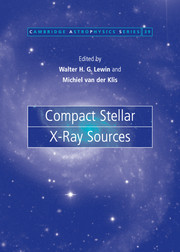Book contents
- Frontmatter
- Contents
- List of contributors
- Preface
- 1 Accreting neutron stars and black holes: a decade of discoveries
- 2 Rapid X-ray variability
- 3 New views of thermonuclear bursts
- 4 Black hole binaries
- 5 Optical, ultraviolet and infrared observations of X-ray binaries
- 6 Fast X-ray transients and X-ray flashes
- 7 Isolated neutron stars
- 8 Globular cluster X-ray sources
- 9 Jets from X-ray binaries
- 10 X-rays from cataclysmic variables
- 11 Super-soft sources
- 12 Compact steller X-ray sources in normal galaxies
- 13 Accretion in compact binaries
- 14 Soft gamma repeaters and anomalous X-ray pulsars: magnetar candidates
- 15 Cosmic gamma-ray bursts, their afterglows, and their host galaxies
- 16 Formation and evolution of compact stellar X-ray sources
- Author index
- Subject index
2 - Rapid X-ray variability
Published online by Cambridge University Press: 01 September 2009
- Frontmatter
- Contents
- List of contributors
- Preface
- 1 Accreting neutron stars and black holes: a decade of discoveries
- 2 Rapid X-ray variability
- 3 New views of thermonuclear bursts
- 4 Black hole binaries
- 5 Optical, ultraviolet and infrared observations of X-ray binaries
- 6 Fast X-ray transients and X-ray flashes
- 7 Isolated neutron stars
- 8 Globular cluster X-ray sources
- 9 Jets from X-ray binaries
- 10 X-rays from cataclysmic variables
- 11 Super-soft sources
- 12 Compact steller X-ray sources in normal galaxies
- 13 Accretion in compact binaries
- 14 Soft gamma repeaters and anomalous X-ray pulsars: magnetar candidates
- 15 Cosmic gamma-ray bursts, their afterglows, and their host galaxies
- 16 Formation and evolution of compact stellar X-ray sources
- Author index
- Subject index
Summary
Introduction
One of the principal motivations for studying X-ray binaries is that accretion onto neutron stars and black holes provides a unique window on the physics of strong gravity and dense matter. Our best theory of gravity, general relativity, while tested, and confirmed, with exquisite precision in weak fields (GM/R ≪ c2; e.g., Taylor et al. 1992) has not yet been tested by direct observation of the motion of particles in the strong gravitational field near compact objects, where the gravitational binding energy is of order the rest mass. Among the extreme predictions relativity makes for these regions are the existence of event horizons, i.e., black holes (Section 2.4.1), the existence of an inner radius within which no stable orbits exist, strong dragging of inertial frames, and general-relativistic precession at rates similar to the orbital motion itself, ∼1016 times as fast as that of Mercury.
In a neutron star the density exceeds that in an atomic nucleus. Which elementary particles occur there, and what their collective properties are, is not known well enough to predict the equation of state (EOS), or compressibility, of the matter there, and hence the mass–radius (M–R) relation of neutron stars is uncertain. Consequently, by measuring this relation, the EOS of supra-nuclear density matter is constrained. As orbital motion around a neutron star constrains both M and R (Section 2.8.1), measurements of such motion bear on the fundamental properties of matter.
- Type
- Chapter
- Information
- Compact Stellar X-ray Sources , pp. 39 - 112Publisher: Cambridge University PressPrint publication year: 2006
- 334
- Cited by

